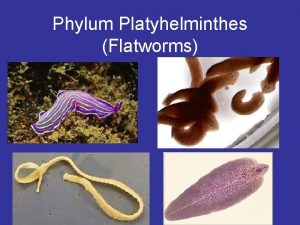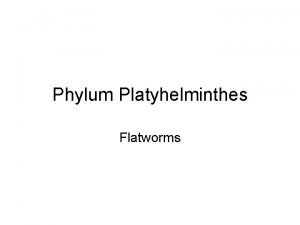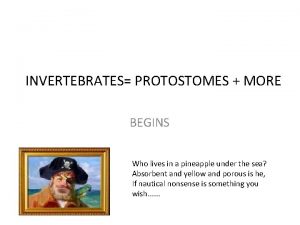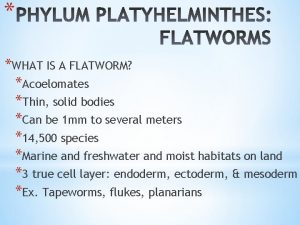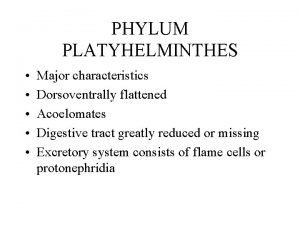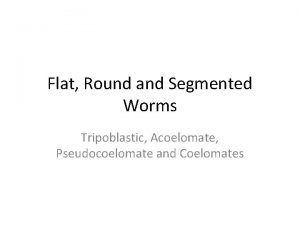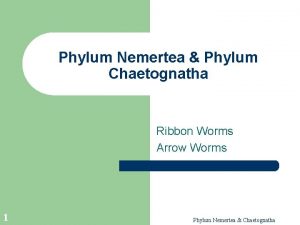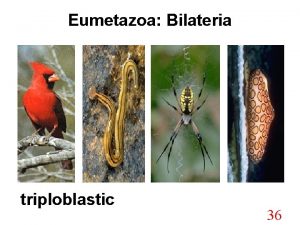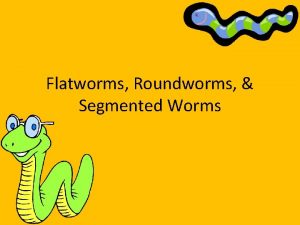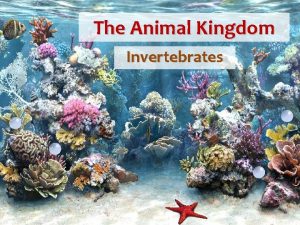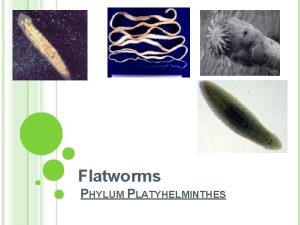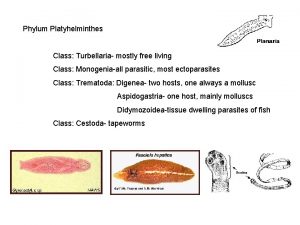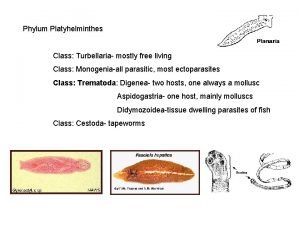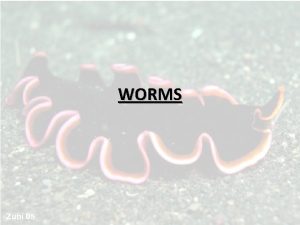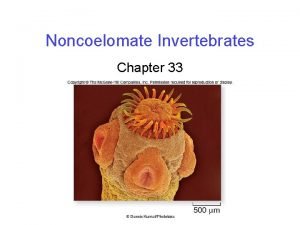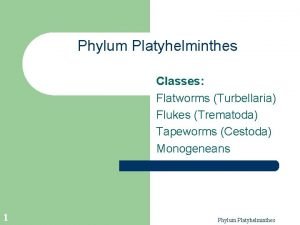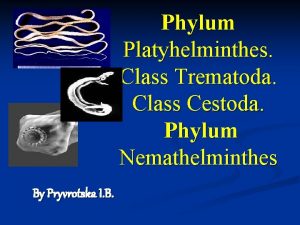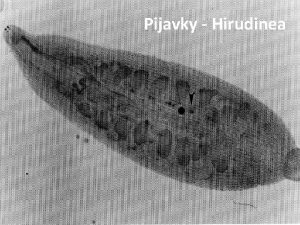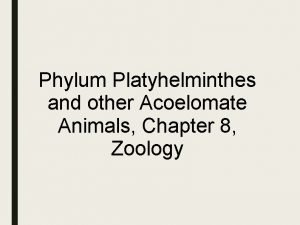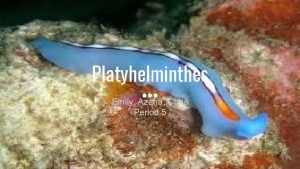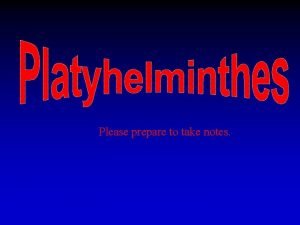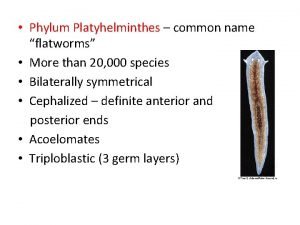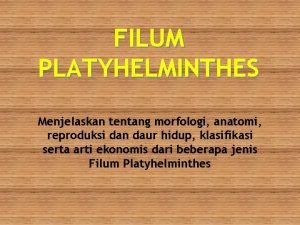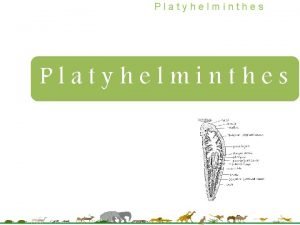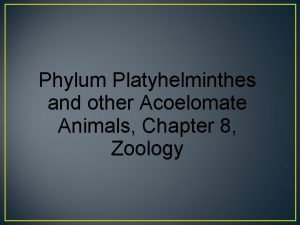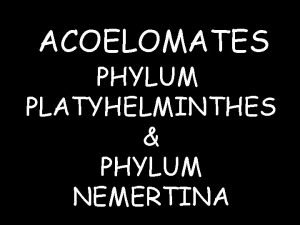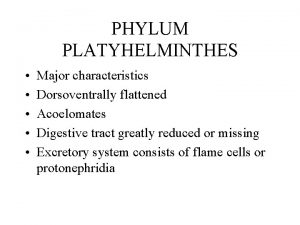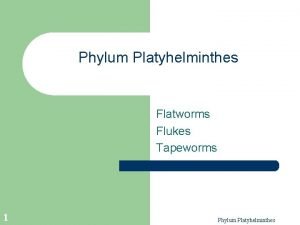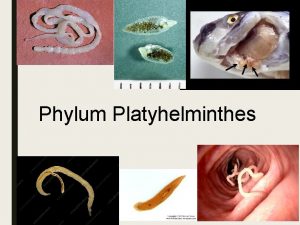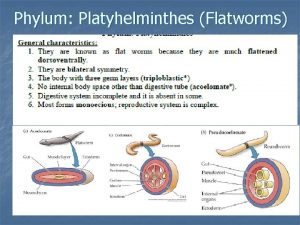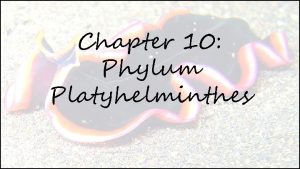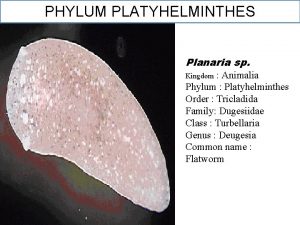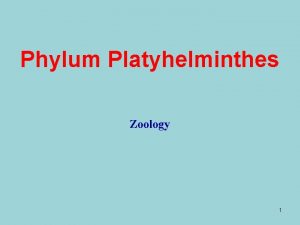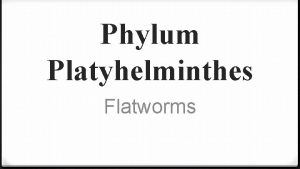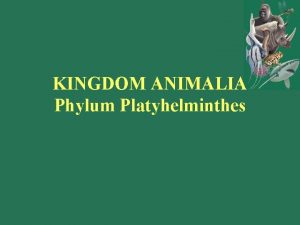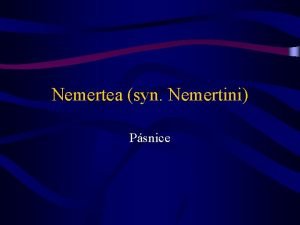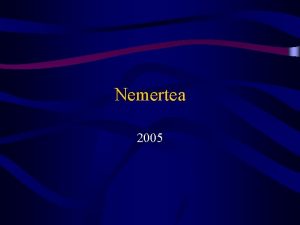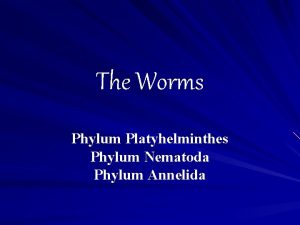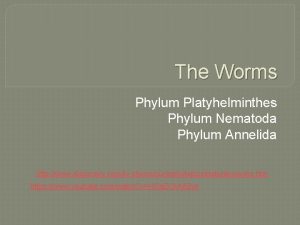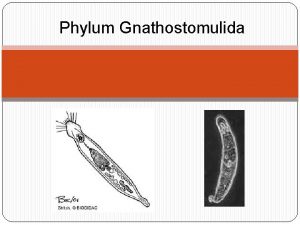Acoelomates Phylum Platyhelminthes Phylum Nemertea Phylum Gnathostomulida Taxonomy





























- Slides: 29

Acoelomates Phylum Platyhelminthes Phylum Nemertea Phylum Gnathostomulida

Taxonomy

Acoelomate Phyla • Platyhelminthes – Flat worms • Nemertea – Ribbon worms • Gnathostomulida – Jaw worms

Why bilateral symmetry? ü Movement toward prey or host – Cephalization – Directional sense organs • Chemoreceptors • Ocelli (light sensing eyespots) • Rheoreceptors (sense water currents)

Acoelomates Key Features • Three germ layers – Ectoderm, endoderm, mesoderm – Mesoderm forms muscle and mesenchyme • Organ-system level of organization – Cephalization – Excretory system – Some have circulatory and one-way alimentary canal

Acoelomates Body Plan

Phylum Platyhelminthes • Specialized Cells – Rhabdites - secrete mucous sheath – Tegument - outer covering of syncytial cells – Flame cells – Osmoregulation – Some have endolecithal egg cells – yolk contained within egg cell

Platyhelminthes Cross Section

Tegument • Syncytium – Apical cell membrane missing

Flame Cell • Osmoregulation – Beating flagella creates negative pressure to draw fluid into chamber – Water is directed through channels then through an external pore

Major Classes of Platyhelminthes • Class Turbellaria – Planaria – free living • Class Trematoda – Liver flukes – endoparasites • Class Monogenea – Fish ectoparasites • Class Cestoda – Tape worms – endoparasites

Class Turbellaria • Key Features – Ladder like nervous system – Eye spots (Ocelli) – Auricles - chemoreceptors – Free living flatworms – Muscular and ciliary movement – Carnivorous

Planarian Body Plan

Class Trematoda • Similar in structure to Turbellaria • Special adaptation for endoparasitic life style – Cyst glands – Suckers and hooks for griping host • Digenetic – complex life cycle with multiple hosts

Liver Fluke

Liver Damage Caused By Flukes • Scar tissue • Blocked bile ducts

Flukes in Liver Section

Fasciolopsis - Anterior End

Schistosoma mansoni • Blood fluke • Male and female are dioecious

Schistosoma cercaria

Class Cestoda • Tapeworms - endoparasites • Key Features – Lack a digestive system – Composed of reproductive units called proglottids – Adult tegument covered in microvilli-like projections – increases surface area, non-ciliated

Tapeworm • New proglottids are added just behind the scolex

Tapeworm Tegument • Microvilli help with food adsorption • Sensory cells – no other sense organs

Mature Proglottid • Reproductive unit • Mature proglottids are either shed or produce shelled embryos • Each proglottid has both male and female organs

Tape Worm Life Cycle

Taenia solium Pork tapeworm

Taenia Cyst in Muscle

Phylum Nemertea • Ribbon worms – Ciliated epidermis – Locomotion – gliding over slime track and muscular contraction – Complete digestive tract – mouth and anus – Extracellular digestion – Proboscis to capture prey

Amphiporus
 Platyhelminthes acoelomate
Platyhelminthes acoelomate Turbularia
Turbularia Are lobsters protostomes
Are lobsters protostomes Are flatworms acoelomates
Are flatworms acoelomates Monogenea
Monogenea Nemertea
Nemertea Chaetognatha diagram
Chaetognatha diagram Nemertea life cycle
Nemertea life cycle Is platyhelminthes triploblastic
Is platyhelminthes triploblastic Marzano taxonomy verbs
Marzano taxonomy verbs Segmentation nematoda
Segmentation nematoda Annelida phylum
Annelida phylum Phylum platyhelminthes characteristics
Phylum platyhelminthes characteristics Characteristics of platyhelminthes
Characteristics of platyhelminthes Genital atrium
Genital atrium Phylum platyhelminthes class turbellaria
Phylum platyhelminthes class turbellaria Plat ee
Plat ee Vas efferens vs vas deferens
Vas efferens vs vas deferens Phylum platyhelminthes characteristics
Phylum platyhelminthes characteristics Classification of platyhelminthes
Classification of platyhelminthes Phylum of flukes
Phylum of flukes Where are liver flukes found
Where are liver flukes found Platyhelminthes adalah
Platyhelminthes adalah Characteristics of flat worms
Characteristics of flat worms Platyhelminthes
Platyhelminthes Tubellarians
Tubellarians Flatworm acoelomate
Flatworm acoelomate Platyhelminthes reproduksi
Platyhelminthes reproduksi Metamorfosis cacing
Metamorfosis cacing Degusia
Degusia
